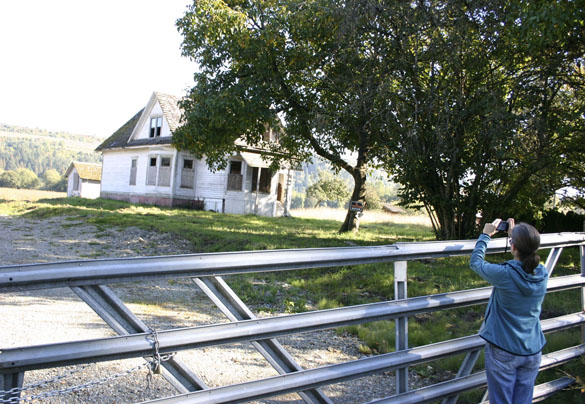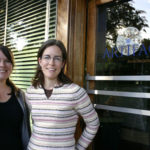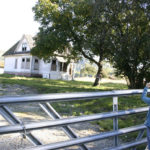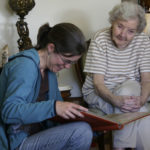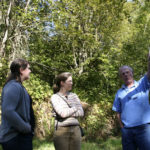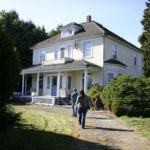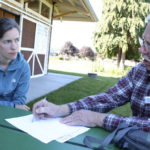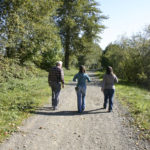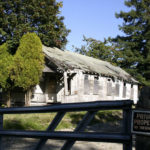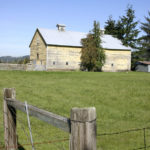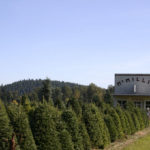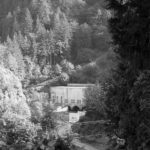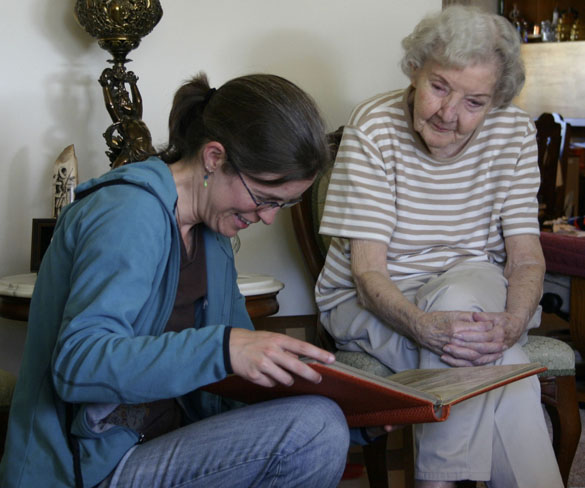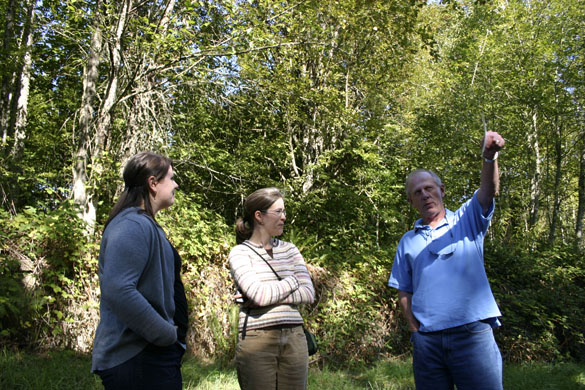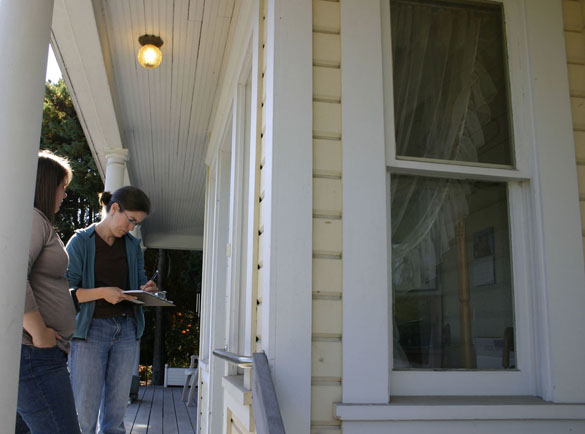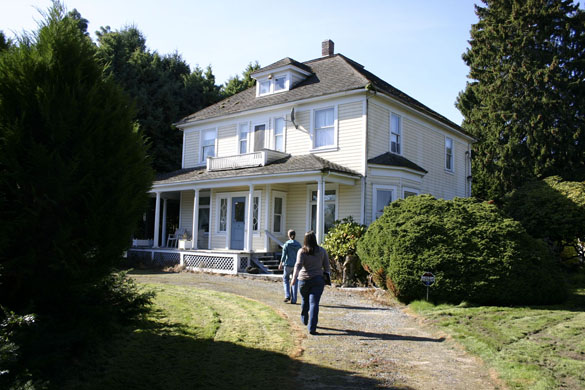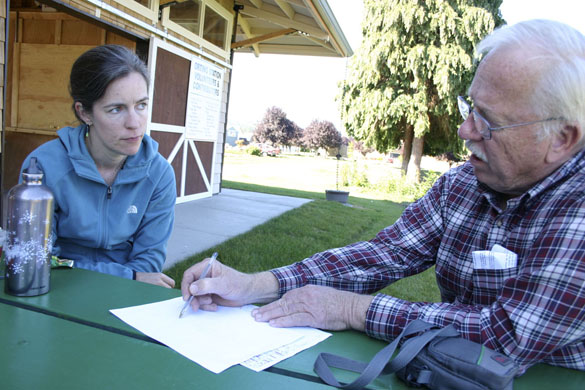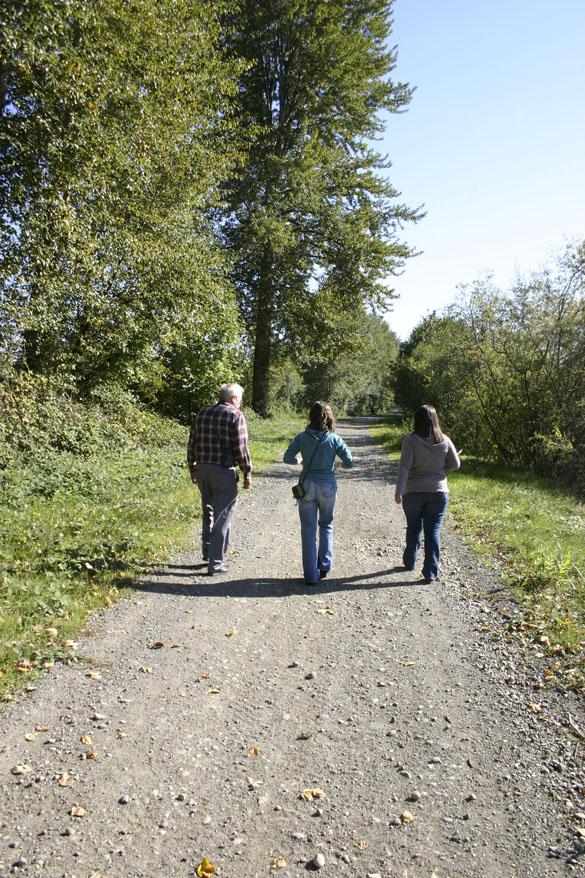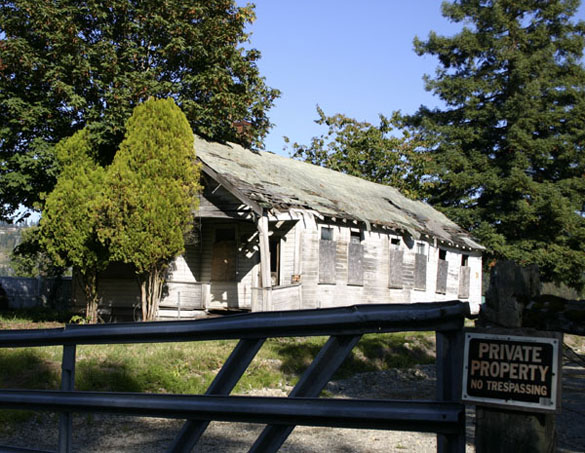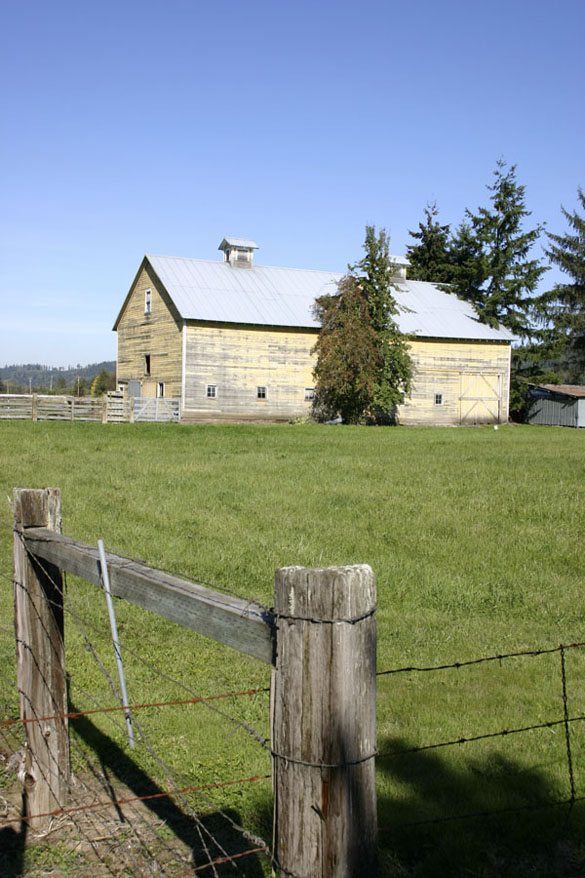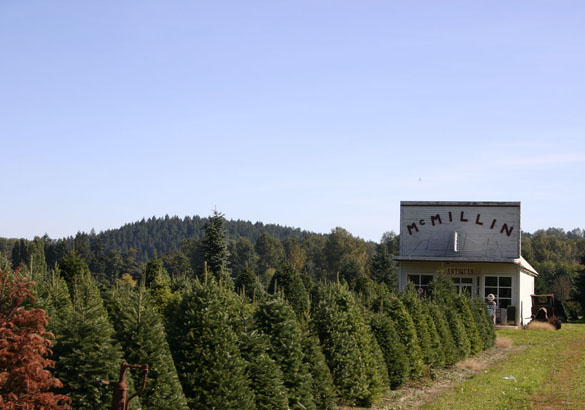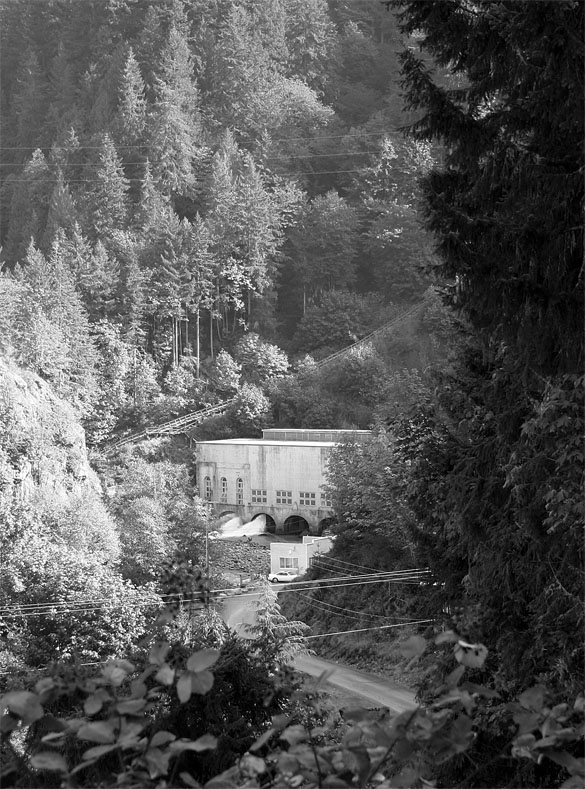ON A BRIGHT and cloudless Tuesday morning in October, Susan Johnson and Katie Chase, two architectural historians, walked down a dirt road in rural Pierce County. They crossed train tracks and a paved pedestrian trail, and made their way toward an enormous barn that sat like a grounded zeppelin against thickly forested foothills. The barn caught Johnson’s eye from the shoulder of Highway 162, about a quarter-mile away, and questions were already running through her mind: How old is it? What was it used for? What is its history?
Johnson and Chase were determined to learn more. It was their job.
The pair works for Artifacts Architectural Consulting in Tacoma. Since the beginning of September, they have driven to nearly every pocket of rural Pierce County — former mining settlements, ghost towns, ruins of logging mills, and even an abandoned slaughterhouse — to document historic sites and buildings. Their work is a milestone survey that, when completed next spring, will give local historians, county councilmembers, urban planners, developers, and even regular residents a better understanding of the region’s history and historically significant buildings.
The barn that piqued Johnson’s interest is in Alderton, located on 18 acres that also include an old residential home. Two cars were parked outside the home and noise from a television could be heard inside. Chase waited in the driveway as Johnson knocked on the door. Several moments passed before an old man with tousled gray hair and ashen stubble, wearing loose blue jeans and a sweatshirt, slowly opened the door.
“Good morning,” Johnson said cheerfully. “Sorry to bother you. We’re working on a history project. I was wondering if you knew anything about that barn or the history of this area.”
In a quiet, scratchy voice, the man introduced himself as Herman Kiser. He explained the barn was built in 1938 and was part of a dairy farm for many years. As a teenager, he climbed to the top of the barn to help hang shingles. “When you’re that young, you’re a Daring Dan,” he said, smiling. He pulled the front door open a little wider, allowing two grey pit bull puppies to bound out of the house, barking and sniffing the visitors. One found Johnson’s thermos, which she had set down on the gravel driveway, knocked it over, and proceeded to hungrily slurp the tea with milk that poured out.
Kiser provided some more information on the area. Hop farms and daffodil farms once lined the valley. A woman who wrote about local history for the daily paper lived on the other side of a stand of trees. He had some old aerial photographs that he could share, but he would need a day or two to dig them out of storage. Johnson handed Kiser her card and a letter describing the project. “Our report will be out next spring,” she said. “If you find those photos or other historic photos, we’d love to see them.”
Johnson and Chase were leaving down the gravel driveway when Herman’s younger brother, Joe Cavelti, came running out of the house to offer his own perspective on local history. “I’ve been here since 1937,” he explained. He pointed out the two tallest trees in the area and explained they were brought in by horse and buggy in 1900. During storms, they lean and sway a little too much, making Joe nervous. “I saw a lot of changes right in here. It was kind of a hustle-and-bustle place around here after the railroad was built in 1882. Alderton was sort of a railroad stop, and Northern Pacific built a warehouse here. They used to fill it with hops. That has been gone 20 or 30 years now. The post office was torn down. There was a general store. Right out here there was a small stop-over hotel. That was torn down in 1937.”
For the past six weeks, Johnson and Chase have had similar encounters. Their typical routine is to photograph old sites from public rights-of-way. Chase completes a one-page form that captures everything from the type of structure, architectural style, cladding, roofing, foundation, and GPS coordinates. Johnson shoots a series of photographs with a digital camera. Invariably, though, someone will see them walking around town and ask about the project. Before they know it, they’re jotting down a long-time resident’s personal history.
“There’s definitely a lot of community pride in some of the areas that don’t get as much recognition because they are small or their industry has left,” Chase told me. “Everyone is so excited to tell us as much as they can about their hometown and the surrounding area.”
JOHNSON AND CHASE aren’t the first historians to make repeated treks out to rural Pierce County to record history.
In 1980, Caroline Gallacci, a historian and author of several books on local history, grabbed a notebook, a stack of United States Geological Survey maps, and a camera loaded with black-and-white film, and climbed behind the wheel of a Pierce County fleet vehicle. Gallacci, then a county employee, logged thousands of miles traveling to unincorporated pockets of Pierce County to record the number of historically significant properties in the area.
“It was just me, outside, by myself,” recalled Gallacci during an interview with the Tacoma Daily Index in 2007. “I’m amazed I survived. I encountered some interesting things. There were signs on people’s fences that read, ‘If you work for the government, don’t come in here.’ I didnt know until after I was there, but there were places around Roy where I shouldn’t have gone because there were informal shooting ranges.” Still, in many areas, long-time residents and informal historical societies helped Gallacci gather data. “People I met along the way who knew about the community would drive me around and show me places I wouldn’t have known about otherwise.”
For nearly a decade — between 1980 and 1989 — Gallacci poked around compiling the first historic resources inventory for Pierce County. “I preferred to call it a reconnaissance survey,” said Gallacci. “At the county, we didn’t have a lot of time, and we didn’t have a lot of money. It wasn’t a comprehensive survey.”
Still, Gallacci’s work is impressive. It is estimated she documented 2,000 to 3,000 properties and sites. But for 20 years, it was the only document of its kind in the county. With each passing year, the survey grew more outdated. Some properties have been razed, some are overgrown and hard to find, and still others have been added to the local landmarks register.
This year the Pierce County Landmarks and Historic Preservation Commission awarded $110,000 to Artifacts to undertake a new historic property survey. Similarly, Historical Research Associates, Inc., was awarded $60,000 to conduct a survey of historic documents including photographs, maps, newspaper clippings, and oral histories. The County Council authorized an additional $70,000 for five cities with historic preservation programs to do their own historic property surveys. The projects are funded by a $1 recording fee surcharge passed by the Washington Legislature.
The results will be compiled in a database that will be available to historians, educators, researchers, and the general public online via the Pierce County Library System by next year. More than simply a list of old buildings, they are creating a sort of Pierce County biography. “Our project will be a little different [from Caroline’s] because we are writing what will be the first ever comprehensive Pierce County history context,” Johnson explained. “We’re telling much more of the story of Pierce County. The property inventory will illustrate that context statement. So when we talk about mining or logging, we will have pictures from then and from now to show what that history looked like. We want to know how everything relates. Ideally, our report will show the interconnection, the relationships, between communities and land uses, and who settled here along with Native Americans. Basically, it will show how Pierce County developed.”
Before field work began, Johnson spent two months researching property records from the county assessor’s office, annual reports, city directories, newspaper articles, and Gallacci’s 1980s survey. It would be impossible to document every historic site. Instead, they will have a representative sample of approximately 900 sites; 400-500 will be updates of the original survey, and the rest will be new additions. Cities and towns with their own historic preservation programs are excluded from the survey: Gig Harbor, Lakewood, Steilacoom, Tacoma, and Puyallup. Similarly, Federal and State properties (Mt. Rainier, Fort Lewis, and McNeil Island, for example) are also excluded because they have their own mandates for managing cultural resources. Still, that leaves a lot of territory: Fruitland, Summit-Waller, Alderton, McMillin, Carbonado, Wilkeson, Burnett, Buckley, Sumner, Orting, South Prairie, Eatonville, Graham, Roy, Kapowsin, Purdy, Rosedale, Fox Island, Anderson Island, University Place, Fircrest, Elbe, Spanaway, and Parkland. Since Sept. 2, when they began their field survey, up until last week, the pair has completed forms for 227 historic sites.
“We hope to generate interest in the county’s history and maybe reinvigorate the landmarks program,” Johnson told me. “There are community history books out there, but sometimes they are limited publications and aren’t widely available. This will be sort of a county-wide history of all the stories in one place available to everybody.”
MONDAY THROUGH THURSDAY, Johnson and Chase leave Artifacts’ office in Tacoma’s North Slope Historic District. They are equipped with brightly colored printouts depicting the territory they plan to cover for the day (various colors denote various ages of buildings and sites; dark purple spots, for example, might represent an area of construction from a certain decade), a GPS device, laptop computer, and digital camera. They pile into Johnson’s Ford Ranger pickup truck and head out into the county. They pack their own lunches and often eat in the truck or on a picnic table at a public park. If they treat themselves to lunch at a restaurant, it’s usually a working lunch: they pore over their maps, update information on the laptop, and plot out where they will spend the rest of the afternoon. By day’s end they are exhausted.
Last week, I joined them for two days. On the first day, we drove southeast toward Highway 167 before connecting with Highway 162, a rural, mostly two-lane road that slices through the barely-there towns of Alderton and McMillin. We stopped by the fifth generation Spooner Farms — a carefully preserved site with a restored barn and a shop with souvenirs and homemade fudge; from the highway one can see the wide orange spread of a sprawling pumpkin patch — hoping for an interview with the owner. She was unavailable, but Johnson left a business card and a photocopied letter from the county describing the project. We walked out near the highway and studied an old white schoolhouse with bay windows. A crumbling, red brick gymnasium sat on an adjacent parcel. Today the schoolhouse sits abandoned along the highway. Huge plywood boards cover a quintet of ground-floor windows. Weeds are thigh-high and surround the old building. A blue tarp covers a hole in the roof, flapping as gravel trucks thunder past on the highway.
Shortly before lunch, Pierce County Landmarks and Historic Preservation Commissioner Bob Peters called Johnson’s cell phone and we agreed to meet at a picnic table at Orting Station in the center of town. Over sack lunches, Peters, who moved to Puyallup in 1949 and has spent decades photographing Orting’s heritage barns, provided some tips on where to find historic sites and with whom to speak: Had we seen the old county poor farm between Sumner and Orting? Did we talk to Hazel Freehe, the 90-year-old widow who was once secretary of the Association of Rhubarb Farmers and whose father, a prominent architect, designed many of the old buildings in Sumner? Twenty minutes later, we followed Peters along two-lane and gravel roads and around farmsteads that stretched wide and flat like an open sea. We stopped frequently to photograph the area’s oldest barns.
Ten minutes later, we parked in a gravel parking lot just beneath the Orting-Kapowsin Highway and hiked along the top of a dirt levee that bordered the Puyallup River. It hadn’t rained for weeks, and the shallow river exposed rocky sand bars. We walked about a mile, listened to the steady thrum of frogs croaking, warmed ourselves beneath the fall sunlight that beamed through the shingled leaves of the tall trees that lined the levee, and spotted a garter snake and the hatch marks of raccoon paw prints in the muddy, weedy overgrowth. Moments later, we spotted what we came here for: the weather-worn concrete blocks of old flood drift barriers that once quelled the Puyallup River. Johnson shot a set of photographs for the project.
For Peters, the benefit of updating the historic property survey is at least twofold.
First, comparing the new survey to Gallacci’s survey will give people a sense of the historic buildings and other improvements that have been lost over the years. “Some of these properties are going to be looked at a second time,” he told me. “Some of these structures aren’t there anymore. I think the new survey is going to show the threat and rate of loss of some of these historic properties.”
The other benefit is that with cooperation of the Tacoma and Pierce County libraries, this information may be widely available online. “Everything that was done in the 1980s survey ended up in the basement of the Pierce County Library,” he explained. “The public never really knew it existed. Plans call for most of this new information to end up on the Internet where the public can access it.”?
THE FOLLOWING MORNING, I met Johnson and Chase at a cafe in Tacoma’s Stadium District. The pair was exhausted at yesterday’s end, but appeared refreshed and ready for a new day of exploring. Chase settled into a bagel and a latte while Johnson sipped coffee from a thermos.
Both explained their personal interests in historic preservation and architectural history.
Johnson’s early experience working in the field of historic preservation dates back to 1998, when she was an intern on an old farm that used draft animals and historic machinery. A year later, she was an apprentice on the Carriage Hill Farm in Dayton, Ohio — a 40-acre spread dating back to the mid-to-late-nineteenth century. On those farms she did everything from lecturing, to creating a computerized inventory of artifacts, to even carrying out farm work with draft animals. “I even did my time as a docent in costume interpreting the 1880s,” she said, without any hint of irony.
In 1999, she traveled to Guatemala to spend two years as a member of the Peace Corps. When she returned, she remained with the Peace Corps as a program assistant in Washington, DC. She was still interested in historic preservation. “I was introduced to heritage tourism and historic preservation [working on those farms],” Johnson, 34, explained. “I just didn’t know you could make a career of it. Years later I learned there was a field called architectural history.”
She moved to Eugene, Ore., in 2005 to attend the University of Oregon and complete a Masters of Science in Historic Preservation. “I was thinking I would be a barn preservationist, work in small towns that were sort of suffering and trying to reinvigorate their economies through heritage tourism,” she told me. “But then I fell in love with city architecture, too.” Although she finished her thesis and graduated in 2008, she was hired by the Oregon State Parks and Recreation Department the year before to research Golden, an old gold mining settlement in the southern part of the state. In 2008, she was hired by Artifacts Consultant. One of her first projects was to conduct a survey of Washington State’s historic theaters.
Chase, who is 24 years old, grew up in Lewiston, Idaho, and studied history at Whitworth University in Spokane. “Whenever you major in history, everyone says, ‘Oh, so you want to teach.’ I didn’t want to teach — at least not right away.”
I’ve always loved old buildings and have had a love of history,” she added. “I started looking at jobs even before I was ready to apply. Everything I was interested in was related to architectural history. I realized I needed a Masters Degree.” Chase, like Johnson, moved to Eugene to attend the University of Oregon and complete a Masters of Science in Historic Preservation. Her thesis tackled the issue of historic preservation and private property rights in Oregon. She graduated in June of this year and was hired by Artifacts in August. “Not a lot of people start in historic preservation right out of college,” she said. “It’s usually something you work your way into or you discover along the way. I love it. It’s been great.”
What have been the most memorable sites so far?
The Old Cannery in Sumner — a flat, long, and wide building with exposed posts and beams — is high on their list. During their visit, the owners provided a tour of the carefully restored building. They saw the imprints of old cans once stacked high on the floor and left behind when the building was vacant for a period. “I don’t know if they were canning fruit or vegetable produce, but the Puyallup Valley is known for farming,” said Johnson. “That had been the use of this building most of the century. Unfortunately, most of the canneries are gone.”
She added: “We have to confirm this story, but local lore says that during one of the World Wars, the basement, which was naturally below average in temperature, was an unofficial morgue for returning soldiers.”
“It’s great because it’s an old building, you can see that it’s been around for awhile especially if you go inside, but it’s being used for a modern purpose,” said Chase. “I loved that. Any other company could tear it down and build something new if they wanted a warehouse or a big box store. But it’s being used as a furniture warehouse. It shows that old buildings like that can be re-used. And the owners loved their building.”
The Pierce County mining settlements of Wilkeson, Carbonado, and Burnett appealed to Johnson because of her work researching Golden. Very little had remained in Golden: a crumbled building listing to one side; a church; and a general store. On the other hand, the former coal mining settlement of Wilkeson (incorporated in 1909, it has a population of 395 according to the 2000 census) has a small downtown lined with with Old West-style buildings and a historic three-story, sandstone school. “This idea of a company town where you can walk down a street and — even though it has changed over time — you can still see the housing that was built at the time,” said Chase. “Maybe there is new siding or a couple new windows, but you are able to feel, ‘OK, this is what this town was like.’ You still have that idea. Whereas some other areas you have infill or things are completely gone.”
Another favorite find: a log house dating back to the pioneer days. “The owner was very private about it,” recalled Chase. “It was an amazing find because it was tucked back there behind some really old and mature trees that were probably planted when the cabin was built.”
“But people should not go looking for the cabin,” cautioned Johnson. She cracked a smile but was sincere about keeping its location private. She leaned over the table and spoke directly into my recorder. “The owner let us include it in the survey under the condition its location would never be in the newspaper. Your readers should know it’s a cabin out in the middle of nowhere and you’ll never see it. Don’t even bother.”
ON MY LAST day with Johnson and Chase, we drove to Graham, roughly 30 miles southeast of Tacoma, past strip malls, box stores, bikini espresso stands, and fast-food restaurants that line most of Highway 7 through Parkland and Spanaway. We were to meet Lawrence D. “Andy” Anderson. Anderson lives on 10 acres passed down to him over the years. An earlier generation of his family arrived in Tacoma in 1890, and the land was purchased in 1946. These days, Anderson is retired from the Federal Aviation Administration and lives on the land with his wife, Shirley. Among local historians, Anderson is known for writing “In the Shadow of the Mountain,” a history of Graham, Kapowsin, Benston, and Electron. These are towns and settlements where, no matter where you stand, Mt. Rainier sits large and round on the horizon like a nearby planet. Johnson had contacted Anderson about the project. He, in turn, had provided a list of some of the historic sites in his area. Johnson wanted to know if Anderson would be willing to provide a guided tour.
When we arrived, we ate our sack lunches in Anderson’s dining room and stepped out on his deck to admire his vegetable garden and the trees that ringed his property line. Anderson warned there wasn’t much left of the original settlements and towns of Graham, Kapowsin, and Electron. “It’s truly amazing how quickly things made of wood return to the earth,” he said. “But the fact they were made of wood is the primary reason there are few traces. Fires were frequent and there was little that could be done to combat them.”
The few buildings that did not succumb to fire were often in the path of progress and were demolished in the last 20 to 30 years. “The state took out most of the Graham buildings that had historic value and there was little or no advance warning of their demise,” he explained. The feed store was replaced by a Walgreens. The widening of Meridian Road destroyed many of Graham’s early homes and stores, including the shop where Anderson, as a boy, used to ride his bike to purchase bubble gum. The school in the former town of Thrift was razed to make way for a mega-church.
We climbed into Anderson’s car and followed the dashboard GPS toward Kapowsin. When we arrived in Kapowsin, he pointed to what was once the center of town and told us to envision a mill, a long row of storefronts, and cabins. Today, Kapowsin is a collection of single-lane streets lined with trailers, run-down houses, and front lawns cluttered with junk: a black Ford Mustang that appeared to have been in a severe roll-over accident sat on bricks in one family’s side yard; broken trampolines sat in the yards of several houses; grey satellite dishes clung to many rooflines like barnacles on ancient, grounded ships. Anderson parked the car and we crossed a street to stand outside what was believed to be the site of Kapowsin’s school. The only thing left was the broken foundation; a staircase of chipped stone that rose a few feet through a thicket of thorny bushes taller than all of us. I walked into a spider web as we made our way through the small passage, as though entering an enchanted forest in a children’s story. Around the corner, we drove maybe 30 yards along a dirt road and parked atop a hill that overlooked the former Tacoma East railroad line. We walked a leafy trail to the hill’s edge, and found splintered chunks of wood buried deep in the hillside — what little remained of a former bridge that once connected Kapowsin to Tacoma, and all parts west.
Leaving Kapowsin, Anderson sighed. “I wish there was more to show you, but unfortunately time has taken its toll.”
From there, we followed Orting Road along an edge of Lake Kapowsin. We stopped briefly at a boat launch on the lake and spied old pilings that were once part of a saw mill. Anderson flipped to a historic photo from his book and held it up to the area of the lake where the mill once sat. The mill was gone, but the tree-line and some pilings appeared to match.
We eventually arrived near the former hillside settlement of Electron. Before heading up into the hills, Anderson pulled over and we surveyed a stone chimney that rose out of roadside bushes like an old ruin. It had the engravings of the Civilian Conservation Corps (CCC) of the 1930s — a program introduced under Franklin D. Roosevelt’s Administration that aimed to put unemployed men to work building dams and roads, and working in forests. One could assume the chimney was part of a large building that once sat on the CCC work camp. But today there is little evidence of such a structure. The land now belongs to Hancock Lumber.
We piled back in the car and made the steep drive to Electron and its namesake hydroelectric dam, the first such dam in Pierce County. The settlement was created in 1903. A portion of the Puyallup River was rerouted through a narrow gorge in order to power Tacoma’s homes and streetcars. Today the dam is operated by Puget Sound Energy and a public park overlooks the area. Although a mudslide in 1936 wiped out most of the buildings, a tall, wide, chalky-colored powerhouse sits solidly between fir trees. On the day we visited, two turbines pumped the river water out, emitting a distant hum.
Anderson drove us back to his house in Graham. It was just after 4:00 p.m. and Johnson, Chase, and I still had a long commute to Tacoma. During the drive back, I was reminded of something I asked them during our coffee shop conversation. I wanted to know if they felt a sense of responsibility and stewardship in documenting many of Pierce County’s historic sites. They responded quickly and together: “Yes!”
“These will be the historic photographs people will look at 60 years from now,” said Johnson. Her tone was less pomp-and-circumstance and more I-hope-our-work-holds-up-long-after-we’re-gone. “People will look back and say, ‘This was my grandmother’s house in 2009. You don’t want to overlook something and then have a story forgotten. In 20 years, when they do another survey, that building that told this important story is gone. But it’s really hard. It’s a big county. I wish there were 36 hours per day.”
Chase’s comment was more to the point: “This might be the first time the county’s history is down in one document. I don’t want to miss anything.”
Todd Matthews is editor of the Tacoma Daily Index and recipient of an award for Outstanding Achievement in Media from the Washington State Department of Archaeology and Historic Preservation for his work covering historic preservation in Tacoma and Pierce County. He has earned four awards from the Society of Professional Journalists, including third-place honors for his feature article about the University of Washington’s Innocence Project; first-place honors for his feature article about Seattle’s bike messengers; third-place honors for his feature interview with Prison Legal News founder Paul Wright; and second-place honors for his feature article about whistle-blowers in Washington State. His work has also appeared in All About Jazz, City Arts Tacoma, Earshot Jazz, Homeland Security Today, Jazz Steps, Journal of the San Juans, Lynnwood-Mountlake Terrace Enterprise, Prison Legal News, Rain Taxi, Real Change, Seattle Business Monthly, Seattle magazine, Tablet, Washington CEO, Washington Law & Politics, and Washington Free Press. He is a graduate of the University of Washington and holds a bachelor’s degree in communications. His journalism is collected online at wahmee.com.
